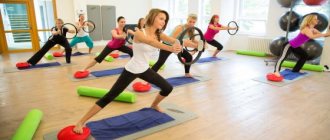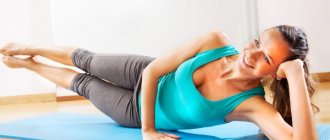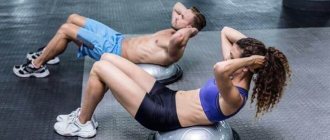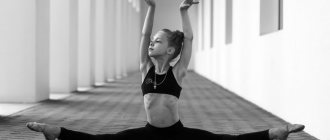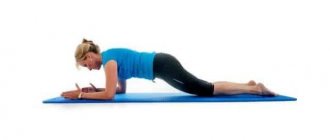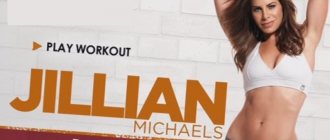≡ February 25, 2020 Category: Mind & Body
In the modern world, where everyone harbors a desire to be beautiful, it has become not only relevant, but also fashionable to take care of your health and visit a gym or fitness center. Therefore, many beginners, when choosing the optimal direction of sports activity, are faced with the concept of Pilates. This system, which arose not so long ago thanks to Joseph Pilates, combines elements of gymnastics, yoga, and fitness and is therefore extremely popular all over the world. Pilates is especially in demand for beginners, which is explained by the effectiveness of the exercises, the ease of performing them in almost any conditions and the lowest risk of injury. And today we will tell you what is special about this direction, and what Pilates exercises you can master at home.
Pilates is one of the few systems that has a complex beneficial effect on the body, increasing its physical characteristics (flexibility, mobility, plasticity) and allowing you to create an ideal figure.
A few important rules
Any gymnastics (and Pilates with a ball is no exception) should begin with mastering several important rules. Otherwise, in the absence of experience, it is easy to get injured. These mandatory requirements for beginners include the following:
It is better to conduct the first lessons with an instructor.- All movements should be smooth - no jerks or excessive efforts.
- You cannot take long breaks from training, otherwise all your efforts will be in vain (the only exception is illness or poor health).
- You need to choose the right ball (the store managers will tell you how its size relates to your height).
- If severe pain occurs, the exercise that caused it should be temporarily excluded from the list.
- Choose the most comfortable clothes and shoes for classes.
- Do not use dumbbells until your muscles are ready for such loads.
Exercise only in a good mood! This can be helped, for example, by your favorite music.
Execution Features
Features of performing exercises include breathing tactics and smooth movements. During Pilates training, it is important to breathe through the chest, while inhaling, drawing in enough air to expand the ribs. When exhaling, you should try to contract the working muscles as much as possible.
Control of the abdominal muscles is also a necessary requirement. When carrying out movements, it is important to constantly keep the abs tense, using it as an energy source for the whole body.
To strengthen your back and increase the flexibility of your body, you should try to smoothly stretch your spine while doing exercises. By gradually increasing the distance between the spinal discs, you can achieve excellent results in the plasticity of the body, as well as strengthening the muscle corset that supports the musculoskeletal system.
Pilates on balls - benefits
What benefits will a good Pilates routine bring to your body? Among the main advantages are:
joints gain much better mobility, and muscles and ligaments gain strength and elasticity;- correction of posture and gradual weight loss - provided that exercise is combined with proper nutrition (an important point for girls and women);
- stabilization of metabolism;
- improving the functioning of the cardiovascular system;
- gradual cessation of back pain (if any);
- activation of blood circulation in the pelvic area (important for intimate health);
- versatility of impact on a wide variety of muscle groups.
First training
There are about three dozen Pilates exercises for people just starting to get acquainted with the system. But in order to master the technique and understand the principle of D. Pilates’ method, it is enough to learn how to perform about ten simple exercises that are ideal for your first workout.
You need to start your workout with a warm-up, as indicated above. To warm up your muscles, you can perform the following exercises:
- Starting position – lying on your back on the floor. Inhaling deeply, tighten your abs and begin to lift your legs, bending them and pulling your knees towards your chest. In this case, you need to press your legs tightly to your body with your hands, linger in this position for a few seconds, and then exhale. While remaining in this position, you still need to perform 3 cycles of inhalation and exhalation. It is recommended to do 2 repetitions of the exercise.
- I.p. – the same as in the previous case. With your arms outstretched to the sides, you need to raise your legs bent at the knees so that the thigh and shin form a right angle. From this point, lower the legs simultaneously to the right, then to the left. Tightening your abs, you need to take deep breaths and exhales, lingering at the top point.
How to choose a Pilates ball
Fitness balls (also used in Pilates), depending on their size, are divided into two types:
fitballs – with a diameter from 45 to 90 cm;- miniballs are small, from 10 to 20 cm, but heavy, from 1.5 to 2 kilograms.
How to choose the right ball?
- The small one should fit comfortably in your hand.
- Large is selected according to height (the simplest formula is height minus 110).
- The material is only high-quality polymer (ideally PVC, a little worse - latex, the most budgetary - rubber).
The kit must include a pump.
Be sure to check out the article “Everything you need to know about choosing a fitball“
Pilates classes
What is Pilates in fitness?
At the beginning of the 20th century, an authoritative sports expert named Pilates thought through in detail and put together a range of effective exercises. This harmonious system will help you properly work out your entire body and relieve stress. Pilates is loved by millions of people from different parts of the world. The secret of the exercise system is the combination of a person’s mental and physical efforts. Particular attention in Pilates is paid to proper breathing, strengthening the abdominal muscles and coordination of movements.
Pilates strengthens your abs, helps you lose weight and improves your back health
Types of Pilates
Each branch of Pilates has its own priorities:
- basic Pilates - a standard optimal set of exercises for beginners with a minimum amount of weights and equipment to strengthen joints, muscles and bones (Pilates Basi);
- stretching Pilates - intensive stretching exercises for girls, where joints and ligaments are involved in the work and the emphasis is on good posture, increasing muscle elasticity, increasing body flexibility (Stretch Pilates);
- strength Pilates is a large set of strength exercises with equipment such as a body bar, dumbbells for people with experience in strength training, the main goal is to increase endurance and muscle growth (Power Pilates).
What are the benefits of Pilates?
Muscle strengthening
Pilates helps improve muscle elasticity. The main advantage is that the body is strengthened. The center is considered to be the abs, lower back, buttocks and hips. All exercises are focused on this area, which means it is worked out comprehensively. It is important to note that the work involves many deep muscles that are not always possible to pump in other areas of fitness. There is minimal discomfort when doing Pilates. There is no painful strain on the muscles.
Healthy back and spine
Pilates improves the quality of life of people living with osteochondrosis, scoliosis and intervertebral hernia. It is known that serious back problems today strike mainly young people, but even in this case there is every chance of recovery. Pilates combats the cause and effect of spinal defects. Thanks to safe exercises, blood supply to the intervertebral discs improves, body weight decreases, muscle spasm is relieved and a muscle frame is created.
Weight loss
Some people doubt the effectiveness of Pilates for weight loss, because at moderate intensity it burns very few calories. To lose weight you need to exercise regularly and eat right. Pilates is available to people with a lot of excess weight, for whom some fat-burning types of fitness may be contraindicated. Exercise relieves depression and you no longer need to eat away your worries. Pilates relieves swelling, suppresses appetite, replaces fat with muscle and improves metabolism.
Harm of Pilates
Pilates training is considered low-impact and non-traumatic; it is relevant when recovering from illness. If you have serious pathologies, you should consult your doctor before starting classes. Usually, harm to the body is caused when contraindications are not observed, if a person trains independently despite the fact that there are health restrictions. If you decide to do Pilates, then listen to your body. If you have pain or other discomfort, consult a doctor.
Contraindications
It is advisable not to practice Pilates if you have the following disorders and conditions:
- pregnancy;
- diagnosis of obesity;
- osteoporosis, arthrosis and scoliosis in an advanced stage;
- mental illness;
- time immediately after a complex operation;
- acute stage of musculoskeletal system disease;
- ligament rupture, fracture and sprain;
- heart diseases;
- body temperature from 37.5;
- age over 40 years.
If you have acute or chronic health problems, consult your doctor more often, including regarding the selection of physical therapy.
How many calories does Pilates burn in an hour?
A 60-minute workout can burn only 250-280 kcal; this effect is inferior to many other sports for fat burning. The apparatus makes the exercise more challenging and burns more calories. In an hour of working with the cylinder, up to 500 kcal will be burned. If your body has a lot of fat or muscle mass, it requires significant energy expenditure. It is also known that people with different metabolisms have different calorie burning processes. How many kcal you burn will be influenced by your training level and intensity.
What is the difference between yoga and Pilates?
At first glance, Pilates and yoga are similar. There are actually a lot of differences. Pilates was developed in the last century, gymnastics brings body control to the fore, stretching is an additional aspect and is intended to improve health, the pace of the exercises is slow but dynamic. Yoga has been perfected for centuries, it is a spiritual practice for self-knowledge and harmony, the goal is strong stretching of the body, static exercises with a delay of several seconds or minutes.
Pilates can be basic, strength and with an emphasis on stretching
Pilates with a ball from Alena Mordovina
Returning to the main topic of our article – video lessons – it should be noted that the best specialists in the world produce entire courses of them. For example, the famous trainer and strongest woman on the planet Alena Mordovina filmed more than a hundred of them (a separate lesson for working with a specific muscle group). Among them there is Pilates on a ball - video lessons aimed at working deep muscle fibers and creating a slim figure.
In addition, Alena always accompanies demonstrations of exercises with detailed comments, which greatly help beginners master the basics of the Pilates technique, as well as breathe correctly and learn a psychological attitude.
Concept and features of the technique
Exercises according to the D. Pilates system are practiced in almost every fitness center. Therefore, many may have seen a scary-looking Pilates reformer. Undoubtedly, training on such a simulator brings many benefits to the human body. However, beginners can start practicing the technique even at home without the need to resort to special equipment.
But before you start practicing, you need to know the features of this technique and its basic principles. It is worth noting that the Pilates exercise system was developed by D. Pilates, who personally encountered health problems, as a special therapeutic exercise. Therefore, any set of such exercises is designed to reach the deepest and smallest muscles, carefully working each of them.
By regularly practicing according to the D. Pilates method, you can notice the general strengthening effect of the exercises. During such training, a person becomes more resilient, flexible, flexible, physically fit and slender.
This system is considered unique for a number of reasons:
- Pilates classes allow you to strengthen muscle fibers by stretching and pumping them.
- The training is focused on high-quality and thorough execution of exercises with a small number of repetitions.
- Movements should be soft and smooth, with even breathing.
- The technique is designed in such a way that when performing the exercises, all muscle groups are worked out.
- Regular implementation of the complex helps not only improve your health, but also get rid of extra pounds, resulting in a beautiful, fit and slender body.
Those who decide to master this unique practice should first learn how to perform Pilates lessons for beginners using video instructions. They are specifically designed for people with no or minimal sports experience, as well as limited physical capabilities due to injury or illness.
Pilates gymnastics
For beginners
The easiest exercises for beginners to master are boat, mermaid and plank. The technique can be seen in the photo.
For pregnant
Women with a favorable pregnancy can do Pilates. Examples of useful exercises are presented in the photo.
For weight loss
Slimming belly
If you do gymnastics regularly, you can achieve an athletic and toned figure without excess weight. You can see an example of a good set of exercises for a flat stomach in the photo.
Slimming thighs and buttocks
The buttocks and thighs are a problem area for many women. To make your buttocks firm and your thighs sexy, try a few exercises.
Video
If you are confident in yourself and theoretically know all the nuances of Pilates, try practicing at home using video lessons. Below is an interesting example with visual instructions. Training at home does not require any expense and allows you to vary the time of sessions at your discretion.
It may not be easy to practice at home for those who are hearing about Pilates for the first time. To eliminate the problems of a beginner, it is better to work out for some time under the guidance of a trainer in the studio, then you can switch to home mode.
Pilates lessons at home
Equipment
Roll
Roller training helps relieve heaviness in the legs, pain in the head, neck and back. This is an anti-stress tool that calms and lifts your spirits, and removes tension in the lower back. Roll exercises are slow and you need rest between exercises. All movements are performed without tension, you need to be careful with the armpits, inner thighs, inner elbows and knees. The roll can be round standard, cylindrical and elongated. With the help of a roll you can do massage, perform planks, lunges, and abdominal exercises.
Ribbon
Using an elastic band, you can stretch your arms in a lunge, raise your arms or hips from a sitting position, perform crunches, and comprehensively pump your legs while lying down. The projectile perfectly absorbs and loads the body perfectly. To better secure your feet and hands, use a tubular harness with handles instead of a tape band. At the same time, a regular elastic band is longer and in some cases more convenient. The rigidity of the tape is selected according to its capabilities. In one set you need to perform 12 exercises, the last one with significant effort.
Hoop or ring
Traditionally, Pilates uses an isotonic ring. It is not too rough, but at the same time elastic enough so that the necessary muscles are tensed when performing exercises. There is a non-slip rubberized lining on the outside, and handles are also provided. The rings differ slightly in diameter; you can purchase 35-38 cm shells. Large hoops are more suitable for men, small ones for women. With the ring, you perform stands with your arms in front of you, above your head and behind your back, and different variations of squeezing the apparatus with your legs in a lying position.
Cylinder
Exercises with a cylinder help to work out the small muscles located in the abdomen and legs. This apparatus trains balance, develops coordination and flexibility. Using a cylinder can help you lose weight, as it requires a lot of energy to work with it. Exercises help build beautiful buttocks, thighs and stomach. The cylinder can be regular round, half-shaped or in the form of a soft roller. Cylinders are usually placed under the back when performing abdominal exercises. The projectile is also used in the plank. The most powerful exercise is leg lunges using a cylinder.
Ball
Various variations of crunches with knee bends, peak and scissor exercises, pelvic and leg lifts, lateral raises, extension and reverse extension, back and abdominal stretching work well - all this is done using a fitball. The Pilates ball promotes comprehensive development of the abs, allows you to straighten your posture and become slimmer. The exercises are not easy to perform and require balance. Balls come in different sizes.
Basic exercises
Examples of basic exercises:
- exercise one hundred - performed with attention to breathing, stretches the neck and legs, strengthens the center of strength, makes the arms and abs work;
- leg circles - works the hip joint, requires stabilization, engages the lower abs, trains leg flexibility, strengthens leg muscles;
- twisting upward - the muscles of the center of power are activated, an effective massage of the spine;
- downward untwisting - teaches the correct twisting of the pelvis forward, engages the muscles of the power center, massages the spine, and stretches the lumbar muscles well;
- neck stretching - engages the muscles of the power center, stretches the hips, develops mobility of the spine, creates beautiful posture;
- back rolls - an exercise for massaging the spinal column, training the abdominal muscles, and developing coordination;
- stretching the legs simultaneously and alternately - stretches the limbs, strengthens the muscles of the power center, teaches balance;
- breathing exercise saw - heals the lungs, improves the waist, stretches the back of the thigh;
- breathing with twisting of the back - adds strength, strengthens the abdominal muscles and heals the lungs.
The best basic exercises for weight loss:
- boat;
- cancan;
- mermaid;
- criss-cross;
- swing your legs;
- plank
The best basic exercises with a fitball:
- scissors;
- peak;
- abdominal stretching;
- back stretch.
Exercises with a fitball: how, when and how much
Include the techniques suggested below in your basic training or perform them as a separate block every other day. To improve your health and correct fat folds, use 2-3 variations per zone. If the workout is based only on Pilates, use the circular principle, alternating 5-7 practices. To lose weight and improve your health, include exercises for all zones in your complex, and exercise on a tightly inflated ball. If, due to insufficiently developed balance, it is difficult to maintain balance, at first cling to the support.
The number of approaches for women at the initial level is 20 x 2-3. Men do more repetitions and sessions - 30 x 3-4. Everyone selects the load individually. If you are well trained, complicate classic Pilates with a fitball with jumping or exercise with dumbbells. Always start with a warm-up, including bending, rotating your pelvis and knees, and jumping.
Top 7 videos with Pilates ring
We offer you 7 effective videos with an isotonic ring to tone muscles and improve your figure. Classes last for different amounts of time, so you can choose the most optimal program duration for yourself.
1. Pilates with a ring in Russian (55 minutes)
2. Training for problem areas with a ring (35 minutes)
3. Workout with isotonic leg ring (8 minutes)
4. Workout with isotonic leg ring (14 minutes)
5. Workout with isotonic leg ring (40 minutes)
6. Training with an isotonic ring (15 minutes)
7. Ring workout for buttocks and abdomen (12 minutes)
Are there any contraindications?
As already mentioned, Pilates has virtually no contraindications. But there are a number of cases when it cannot be done. These include:
- A strong increase in temperature, from 37.5 and above.
- Inflammatory diseases in the body, accompanied by severe ailments.
- Fractures, tears or sprains are also a serious obstacle to exercise.
- Cannot be practiced with any impairment of motor coordination.
- Osteoporosis, scoliosis, arthrosis and others.
- Mental disorders.
Since classes require full concentration, relaxation and concentration, these diseases can interfere with or worsen. Therefore, if there is at least one item from the list, it is better to abstain from classes.
Push-ups for triceps and biceps
Kneel in front of the apparatus. Place your hands on the floor in line with your shoulders, and lift your legs into the elastic sphere. With a straight body and tense abs, perform a series of push-ups.
Push-ups for triceps and biceps: starting position
Push-ups for triceps and biceps
3 extension options
The back muscles are strengthened not only on a special machine in the gym, but also on a ball.
- Lie on your stomach, straighten up, bring your hands to your lower back and clasp them in a lock. Maintaining balance, lift your upper body.
- Remaining in this position, keep your arms straight in front of you, and pull up along with lifting your torso.
- Now move the projectile closer to the solar plexus and perform reverse extensions with your legs at a measured pace.
What is Pilates History of origin.
An extensive medical record, an unbending will and a clear goal - this is where the history of the legendary healing technique began. At the end of the nineteenth century, a sickly child was born in a small German town. His name is Joseph (Joseph) Pilates. The parents were worried about the baby; ailments rained down on him like from a cornucopia: rickets, colds, rheumatism and asthma. More than anything, Joseph wanted to be strong and healthy, like his gymnast father. From the age of ten, Joe began to train intensively, and by the age of sixteen his figure resembled a Greek statue - this is how the training system won its first victory over weakness. The young man began working as a model and studying the basics of martial arts.
Having moved to Britain in 1912, Joseph performed in boxing rings, performed circus stunts and taught Scotland Yard agents the basics of wrestling. During the First World War, Pilates, a recognized expert, actively introduced the system of exercises he developed in hospitals. The effect was amazing - the functions of the damaged organs were quickly restored, postoperative injuries disappeared without a trace.
Having settled in the USA fourteen years later, Joseph continued to develop his technique. Her popularity quickly spread in ballet circles - the entire New York City Ballet trained under the guidance of the eminent master. Pilates was gaining momentum, becoming the country's favorite gymnastics. “A healthy body is the basis of happiness” - this is the brief concept of exercises that allowed them to win a large army of fans.

